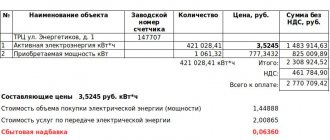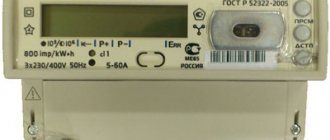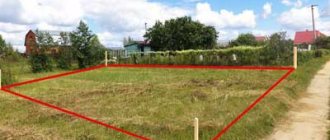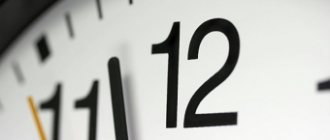What types of counters are there?
An electric meter is a device that keeps track of how much electricity you use. How much electricity he burned is how much he will show on the display in kilowatt-hours. Then for these kilowatt-hours you will need to pay the energy supply organization at your tariff.
Tariffs vary. Firstly, they depend on the region. For example, in Moscow you will have to pay 4.87 R per kilowatt-hour for a single-tariff meter, and in the Istra district of the Moscow region - 3.89 R. Secondly, the meters themselves may have different tariffs. I'll tell you more about this. Tariffs are usually set for a year, in some regions from July 1, in some - from January 1.
In the article I will use the tariffs that were in effect in March 2020 in Moscow
A single-tariff meter operates at only one tariff all the time. Its readings do not depend on the time of day. A kilowatt-hour of electricity will cost the same both day and night.
The cheapest single-tariff meters do not even have a display. In this case, the readings are displayed the old fashioned way - on rotating wheels.
Their operating principle is not the same as multi-tariff ones, which is why they are cheaper
A two-tariff meter is a meter where the tariff depends on the time of day. The device shows on the screen the consumption of kilowatt-hours in two different time intervals, T1 and T2, as well as the total consumption.
Standard time intervals:
- T1 - from 7:00 to 23:00;
- T2 - from 23:00 to 7:00.
Two-tariff meters have a display.
And such a meter, if desired, can be connected to one tariff, then it will work as a single-tariff Three-tariff - the same meter as a two-tariff, but it has three time intervals:
- T1 - from 7:00 to 10:00 and from 17:00 to 21:00;
- T2 - from 23:00 to 7:00;
- T3 - from 10:00 to 17:00 and from 21:00 to 23:00.
Two-tariff and multi-tariff meters have displays on which readings at different time intervals replace each other. The meter then shows the total consumption.
The meters also have parameters such as rated and maximum currents. An ordinary comfortable apartment is not a manufacturing enterprise with high energy consumption. Most modern electricity meters are designed for currents from 5 to 60 A.
Save on housing and communal services
If the load is less than 5 A - this is the rated current - then the device will produce an error and it is not known who will benefit from this. If all consumers in the apartment consume more than 60 A - this is the maximum current - the device may fail. But for an ordinary apartment this is unlikely, so you can ignore these parameters.
This is the cheapest three-tariff meter from Leroy Merlin. It's just a shame that it doesn't have very good reviews. People write that it is programmed by default for one tariff and needs to be reprogrammed for three
What is an electric meter day and night?
As you know, in the domestic sphere, electricity consumption is very uneven.
At night, when the vast majority of people are resting, its analysis is minimal, in the morning and evening hours - maximum, in the daytime - moderate.
It turns out that at some times of the day, supply companies face the risk of network overload, and at other times, even shut down the power plants.
To even out demand, in addition to the regular tariff with a fixed cost per kilowatt-hour, they offer differentiated ones, which provide for the sale of energy during hours of minimum consumption at a greatly reduced price. That is, the population is offered a good deal: you use electrical appliances at night, but at a very low price.
It is clear that a conventional meter is not suitable for a differentiated metering system. We need one that can count consumed kilowatt-hours separately for different times of the day. These devices are called “day and night meters”.
There are two types:
- two-tariff;
- multi-tariff.
Each variety corresponds to its own accounting system:
- The two-tariff system involves dividing the day into two periods (they are also called zones): night (from 23-00 to 7-00) and day.
- Multi-tariff.
The latter already has three zones: night (from 23-00 to 7-00), peak (from seven to nine in the morning and from five to eight in the evening) and half-peak (from 9-00 to 17-00 and from 20-00 until 23-00).
The accuracy of the calculation of consumed electricity directly depends on the accuracy of the meter. Electric meter accuracy class - which one to choose and how to determine?
How long can an electricity meter be used and what is meter verification, you will learn by reading this article.
After installing the electric meter, it must be sealed. Who should do this and how much it costs, this will be discussed in detail in the next article.
Operation
All multi-tariff meters (in this case, two-tariff meters are also meant) are electronic and contain a microcircuit inside. Classic counters, called mechanical or induction, cannot keep separate records.
Before use, a multi-tariff meter must be programmed, that is, its internal clock must be set and time intervals must be set. This operation must be performed by an Energosbyt employee. After its completion, the device is sealed.
Two-tariff metering device
If reprogramming is carried out not because of innovations on the part of the supplier company, but, for example, in order to switch to a different accounting scheme (at the user’s request), then you will have to pay from 500 to 700 rubles for this service. When switching from winter to summer time and vice versa (cancelled in Russia), such meters also need to be reprogrammed.
Three-phase or single-phase design
When purchasing, it is important to clarify for which network this electric meter model is intended.
The signs are as follows:
- A 1-phase device has two terminals on each side, that is, four in total.
- 3-phase has at least four terminals on each side, that is, at least eight in total (there may be additional ones).
Those who live in city apartments need to purchase a 1-phase meter. But owners of private houses, if they do not know the number of phases, should first calculate the number of wires in the line connected to the house. If there are two of them, the network is 1-phase, if there are four, it is 3-phase.
A 3-phase model can be connected to a single-phase network without any problems, so those who currently have one phase, but plan to switch to a 3-phase power supply in the future, can safely purchase a three-phase meter. But, of course, it is impossible to connect a 1-phase meter to a 3-phase network.
The electric meter cannot be returned or replaced if it does not fit. The fact is that when selling a device, a special mark is placed in the passport - because of this, the product, as they say, cannot be returned, unless, of course, a manufacturing defect has been identified.
Therefore, when purchasing, all parameters and characteristics of the meter must be checked with all possible detail. In addition to phasing, pay attention to:
- rated current: must exceed the maximum of the input circuit breaker by one step;
- accuracy class.
An important characteristic is the noise level (some models buzz).
Benefits of installation
It is impossible to say unequivocally that the transition to a multi-tariff electricity payment scheme will be profitable.
Yes, suppliers reduce the cost per kilowatt-hour during the period of minimum consumption by 30% - 60%, but during peak loads they increase it - sometimes up to 30%.
Moreover, there is no single system - each region has its own tariffs.
Let's give an example. In Yekaterinburg and the region in 2014–2015, the following price ratio took place:
- regular undifferentiated tariff: RUB 3.07/kWh;
- two-tariff scheme: day - 3.09 rubles/kWh, night - 1.46 rubles/kWh.
Under such conditions, the transition to differentiated metering for a homeowner with a standard set of electrical appliances will certainly bring benefits: the daily cost in a multi-tariff scheme is almost no different from the usual one (with a single-tariff scheme), so even if residents use electrical appliances only during the day, they will save due to the operation of the refrigerator .
A slightly different picture is observed in Moscow:
- regular undifferentiated tariff: 4.68 rubles/kWh;
- two-tariff scheme, day-night tariff: day - 4.91 rub./kWh, night - 1.26 rub./kWh.
Please note that the daily cost has increased relative to the base single tariff rate. If in Yekaterinburg it is 2 kopecks, that is, less than 1%, then in Moscow it is 23 kopecks, that is, almost 5%.
Three-phase meter Mercury 231 AT 01 i with remote control, two-tariff
Under such conditions, the transition to differentiated accounting should be carefully considered. It is possible that when using devices during normal times, especially if there are many of them or they are quite powerful, the user will have to pay more.
It’s another matter if he is ready to complicate his life a little:
- reschedule washing;
- turn on the boiler only at night, etc.
Two-tariff meters are beneficial for those who are away from home all day. Not everyone knows how to take readings from a two-tariff electric meter.
The principle on which an induction electricity meter works is described in detail at the link.
With such a reorganization, the transition to differentiated tariffs will be justified. In general, you need to think and calculate everything.
People who use autonomous heating with an electric boiler can save a significant amount. The heating system must be equipped with a heat storage device in the form of a large reservoir filled with coolant. This will make it possible to turn on the electric boiler only at night, while during the day the house will be heated using the heat stored in the heat storage tank.
Rates
The cost of electricity for the consumer depends on tariffs. Tariffs depend on the region and time of day.
Regional tariffs are approved once a year by executive authorities in the field of pricing. These bodies are called differently: in Moscow - the Department of Economic Policy and Development of the City of Moscow, in St. Petersburg - the Tariff Committee of St. Petersburg, in Yekaterinburg - the Regional Energy Commission. You can view current rates on their websites:
- Mosenergosbyt
- Petroelectrosbyt
- EkaterinburgElektrosbyt
Tariff time intervals are the same for the whole year and all regions, that is, the peak everywhere begins at 7:00 local time.
1473-eOrder of the FTS of Russia dated November 26, 2013 No.
Peak is the time of the heaviest and most expensive load on the power grid, when most people are at home and using electrical appliances: boiling the kettle, blow-drying their hair, charging devices, and so on. This is usually the time when people are going to or coming from work. Half-peak is a time when a lot of energy is also consumed, but not as much as during peak hours. At night, energy consumption drops as most people rest.
Utilities charge the highest rates during peak periods. To encourage people to use electricity at other times and thereby redistribute consumption, they reduce tariffs for half-peak hours and at night.
Some infographics from the Mosenergosbyt website: electricity consumption increases in May and January, during the long holidays. People spend more time at home, cook food, constantly boil the kettle
There is also a peak in September: this is the time of returning from the dacha
I’ll tell you what affects the cost of a kilowatt hour:
- Locality. Different localities may have different tariffs within the same area. In rural areas the tariff is usually lower.
- Using a multi-tariff meter. If a multi-tariff meter is installed, the cost per kilowatt-hour depends on the time of day. Peak time consumption costs much more than night time consumption. In this way, the state is trying to balance the load on the networks.
- Gasification at home. For houses that cannot be gasified, the electricity tariff is lower. This is social support from the state for those who consume electricity not only for lighting and operating equipment, but also for cooking, heating and heating water.
I will give the tariffs for Moscow, which I used in my calculations. If the house is gasified, the tariffs for houses with gas stoves apply, even if you do not use gas. Next you need to look at the specific tariff depending on the type of meter installed.
How I connected gas in a private house after reconstruction
For a two-tariff meter, two numbers are indicated: the cost of a kilowatt-hour at different time intervals, they are designated T1 and T2. In a three-tariff meter, a third interval, T3, is added.
Tariffs for gasified houses in Moscow from the Mosenergosbyt website
Tariffs for non-gasified houses in Moscow
Tariffs Moscow
They are presented on the website and displayed in the ratio RUB/kWh.
They are also divided into two periods.
These are plans that come into effect from:
- January 01, 2021 to June 30, 2020;
- July 01, 2021 to December 31, 2021.
Apartments and houses with gas stoves
In Moscow real estate properties and houses with gas stoves, the following plans apply:
| Price | ||
| During the period from January 1, 2021 to June 30, 020 | During the period from July 1, 2021 to December 31, 2021 | |
| Single-tariff accounting using a single-rate tariff plan | 5,47 | 5,66 |
| Two-tariff metering using a tariff depending on the time of day | ||
| Night zone T2, i.e. from 23 pm to 7 am | 2,13 | 2,32 |
| Day zone T1 from 7 a.m. to 11 p.m. | 6,29 | 6,51 |
| Multi-tariff metering using a tariff that depends on the time of day | ||
| Night zone T2, i.e. valid from 23 pm to 7 am | 2,13 | 2,32 |
| Half-peak zone T3, from 10 a.m. to 5 p.m. or 9 p.m. to 11 p.m. | 5,47 | 5,66 |
| Peak zone T1 from 7 a.m. to 10 p.m. or from 5 p.m. to 9 p.m. | 6,57 | 6,79 |
Apartments and houses with electric stoves
In properties and houses with electric stoves, the rates will be slightly different:
| Price | ||
| During the period from January 1, 2021 to June 30, 2021 | During the period from July 1, 2021 to December 31, 2021 | |
| Single-tariff accounting using a single-rate tariff plan | 4,65 | 4,87 |
| Two-tariff metering using a tariff depending on the time of day | ||
| Night zone T2 from 23 pm to 7 am | 1,50 | 1,63 |
| Day zone T1 from 7 a.m. to 11 p.m. | 5,35 | 5,60 |
| Multi-tariff metering using a tariff that depends on the time of day | ||
| Night zone T2 from 23 pm to 7 am | 1,50 | 1,63 |
| Half-peak zone T3 from 10 am to 5 pm or from 9 pm to 11 pm | 4,65 | 4,87 |
| Peak zone T1 from 7 am to 10 pm or from 5 pm to 9 pm | 5,58 | 5,84 |
Who should change meters and at whose expense?
The service life of the meters, as stated by the manufacturer, is usually 30 years. But this does not mean that you can do nothing with meters for 30 years. They need to be checked periodically, that is, a procedure must be carried out that will confirm the accuracy of the readings. Verification is usually required every 10 years for three-phase meters and every 16 years for single-phase meters. But there are meters with a calibration interval of 8 years. The frequency of verification is indicated in the device passport.
It is the responsibility of the apartment owner to comply with verification deadlines. If this is not done, electricity consumption will be calculated according to the standard, that is, as if there is no meter at all.
clause 4 section 1 Appendix No. 2 to Government Decree No. 354 dated May 6, 2011
Verification is not cheap: for a single-phase single-tariff meter - from 2500 RUR, for a three-phase single-tariff meter - from 3500 RUR.
When you buy a new meter, pay attention to the calibration interval. The larger it is, the less often you will need to spend money on verification. For example, this meter has a calibration interval of 16 years
If the meter breaks down, is removed, or the service life or verification period has expired, this is equivalent to the absence of a meter. For such apartments, electricity tariffs are set one and a half times higher. To pay normal rates again, residents need to replace the meter or have it checked.
Residents change the meter at their own expense. By law, the owner is obliged to maintain his property himself. The meter also belongs to this property, even if it is installed not in the apartment, but on the stairs. It’s just that in this case it’s easier to service it and take readings.
Functional connection of zones
You also need to take into account that some zones are functionally connected to each other. Therefore, it is better to place them in close proximity. For example, the dining area and the kitchen area . They are united by food, which is prepared in the kitchen and eaten in the dining room. If you put a living room area , then you will need to carry food and dirty plates, maneuvering between the sofa, armchairs and coffee table. Such zoning will make the apartment less comfortable.
The same is true in the bedroom with a sleeping area and a wardrobe. Imagine that between these zones there is a kitchen. And you, waking up in the morning, rush through the kitchen in shorts to get dressed.
These examples seem absurd, but they are examples from life. Just one of those cases when they first come up with a design, and then fill it with function.
Time of night and day tariff
We have already discussed this issue above, but we will cover it in more detail.
Fixing a price for a specific zone helps with the following tasks:
- Reducing load during peak hours;
- Reducing energy consumption;
- Protection of the home electrical network from damage or tripping of protective equipment.
Many people have been in a situation where, due to the inclusion of a large number of receivers in the electrical panel, the machine is knocked out. The reason is excessive load that exceeds the permissible level. For this reason, the input to the house or even the switch at the substation may be turned off.
The transition to a night tariff is relevant for rural residents, who will be able to turn on the heating of their home, greenhouse, and other premises only in the dark. As a result, heating costs are reduced by 30-40%, and sometimes more.
As noted, the two-tariff meter operates in two zones - from 23.00 to 7.00 (night) and from 7.00 to 23.00 (day). However, the night range may vary depending on the number of zones:
- Between 11 am and 7 am. With a two-zone tariff, electricity costs are reduced by 30% for ordinary consumers (individuals) and by 40% for companies (legal entities).
- Between 11 am and 6 am. If a three-tariff meter is used, the payment is even lower. In this case, the payment for night use is 35% of the regular rate (for ordinary citizens) and 40% for companies.
Advantages of night electricity tariff
The second most popular among electricity tariffs is the night tariff, since at this time residents do not actively consume electricity, and therefore can pay less for it, or, on the contrary, rationally adjust their use of equipment at night.
Benefit:
- The property has a summer house where electrical appliances are rarely used;
- If the place of electricity in the house is gas.
In order to understand the rules for installing a new meter, the conditions for payment for the tariff of any phase, it is necessary, as an example, to visit PetroElectroSbyt, where the functionality of a detailed review of each district of the city is possible. It is beneficial to install a meter for two tariffs that is valid by law.
How do you pay?
To make a payment you will need a receipt with the accrued amount for the light, a calculator and a pen.
The algorithm of actions is as follows:
- We take readings from a two-tariff meter for the day and night shifts.
- We take the old receipt, according to which payment was made for the last month, and subtract the previous parameters in the section “On the day of payment” from the figure of the new readings. We multiply the resulting number by the tariff that is valid in the city (region) of residence.
- We subtract from the number of “night” readings the data that is recorded in the old receipt in the column “On the day of payment”. We multiply the resulting number by the tariff that applies to the night zone.
- Sum up the received figures for the day and night, after which we make a payment taking into account the result obtained at the nearest bank branch or in another way (for example, at a Russian Post office).
When paying through a banking institution, the money arrives within one to three days, and the transfer by mail takes place within 1 to 2 weeks.
If a three-tariff meter is installed on an apartment or house, calculations are made for three zones separately - for daytime, peak and night tariffs. Next, the resulting figures are multiplied by the current tariff and added up according to the principle discussed above.
If benefits are provided, the calculation is done as follows. First, we calculate the amount of the discount from the total amount payable and subtract the result from the total amount. After this, the payment is made.
In a situation where the check arrives from a clearing center, it is recommended to make payment according to the indicators from the receipt. As a rule, it indicates the average parameters for the previous year.
At the end of the calendar year, a recalculation occurs, and the overpayment will go to the next year. If any amount is missing, you will have to pay extra.
Example of economic efficiency calculation
Let us make approximate calculations of the efficiency of multi-tariff meters compared to single-tariff ones.
Single tariff meter
Payment for electricity using a single-rate meter is calculated using the following formula: P = V * T, where V is the amount of electricity consumed, and T is the tariff in rubles. Let's assume that a gas stove is installed in the apartment, and 239 kW was consumed in a month. The cost of the tariff in this region is 5.38 rubles. Thus, the payment for the month will be: 239 x 5.38 = 1285.82 rubles.
Two-tariff meter
The calculation for a two-phase meter is somewhat more complicated and is determined by the formula: P = (Vday x Tday) + (Vnight x Tnight), where Vday and Vnight are the amount of energy consumption during the day and night, respectively, and Tday and Tnight are the day and night tariff rates. Let’s assume that a two-tariff meter is installed in the same apartment, according to which the readings were also 239 kW, but broken down by phase: day - 167 kW, and night - 72 kW. The rate for the day is 4.19 rubles, and for the night - 2.92 rubles. Thus, we obtain the following calculation of the total cost of electricity for the month: (167 x 4.19) + (72 x 2.92) = 909.97 rubles.
Three-tariff meter
Calculation using this system becomes more complicated, since additional indicators of the peak zone are added here. Formula for calculation: P = (Vpeak x Tpeak) + (Vpolypeak x Tpolypeak) + (Vnight x Tnight). Let's carry out the calculation using the same data, but differentiated by daily zones. The total amount of consumption for the month is 239 kW, of which: peak zone - 120 kW, half-peak - 47 kW, night - 72 kW. The cost in the region for 1 kW is: peak zone - 6.46 rubles, half-peak - 5.38 rubles, night - 1.79 rubles. The total amount of electricity payment for the month will be: (120 x 6.46) + (47 x 5.38) + (72 x 1.79) = 1156.94 rubles.
Advantages and disadvantages of two-tariff meters
When connecting a two-tariff meter, it is important to consider the pros and cons of such a transition. Let's take a closer look at them.
Advantages:
- For the consumer - a reduction in electricity costs by an average of 30-40%. This is due to the lower cost of electricity at night.
- For energy supply organizations - uniform distribution of load within 24 hours, which reduces overload during peak hours and helps to increase the service life of equipment.
- For the environment - reducing the volume of harmful emissions due to the uniform operation of the power plant.
- For enterprises, it saves energy at night, which helps reduce costs and production costs.
Flaws:
- Electrical appliances are left on at night, resulting in increased noise levels.
- Two-tariff meters are expensive and, according to users, often fail.
Disadvantages of the night meter
They may manifest themselves in the following:
- the need to control the operation of electrical appliances at night, due to savings. As a result, the daily and rest routine of a person and his family may be disrupted;
- With meticulous and targeted savings, the operation of some appliances may disturb neighbors: for example, a vacuum cleaner at night.
- Some users do not feel a significant difference when paying at differentiated rates. This is caused by initially high rates, a large number of household appliances in the house.
Most consumers note the benefits of using multi-tariff meters and want to switch to accurate payment for electricity consumed at certain times of the day.
What is your electricity tariff?
First of all, you need to decide which group of electricity consumers you belong to, and what tariff you need to look at. Firstly
, electricity tariffs for the population are set depending on the type of settlement
( urban or rural
).
Secondly
, tariffs for urban residents vary depending on whether you have
a gas
stove or
an electric one
(electric heating devices).
It is worth considering that the electric stove (heating appliances) must be installed officially, in accordance with the design documents for your home. Thirdly
, electricity tariffs can be calculated based on different rates at different times of the day.
Most of us pay the so-called single-rate
tariff, in which the cost of 1 kilowatt/hour does not depend on the time of day.
However, an increasing number of people are switching to a two-zone
(day-night) or even
a three-zone
tariff. In this case, electricity will cost you less at night and more during the day.
Two-tariff and three-tariff systems
Today, there are three types of electricity metering devices in use, designed for a specific system. There are different types of accounting systems:
- single-phase - the price for electricity consumption is the same at any time of the day,
- two-phase - time days are divided into two zones, and the price for electricity consumption depends on the time of use,
- three-phase - the day is divided into three zones, and the price for electricity consumption depends on the time of use.
It is easier to pay for electricity using a single-phase meter, but using two- and three-phase devices can significantly reduce costs. Let's look at them in more detail.
Two-tariff system
If a double electricity tariff is applied, then the time in the day is divided into two zones, for which different payments are provided. Day zones with a two-tariff system:
- day,
- night.
Payment for night time use is lower than for daytime use. Readings on this meter are transmitted according to two indicators, usually T1, T2. However, the designations may be different, since they depend on the software installation of the meter itself.
Three-tariff system
When using a three-phase system, the temporary day is divided into three zones, for which different payments are also provided. Day zones with a three-tariff system:
- peak,
- half-peak (daytime),
- night
Electricity tariffs for the day, night and half-peak are meant to be different, and if you use powerful household appliances in the “cheapest” zone, you also get good money savings.
Example of "savings"
To confirm the trick hidden in the day-night metering tariff system, we present the calculations of a user who decided to switch to an electronic multi-tariff meter. Not to mention its high cost (on average, the price of such a product is 2-2.5 times higher than that of a conventional device), after a thorough analysis, he discovered the following facts.
Electricity prices at the user’s place of residence are as follows: the daily tariff is 5.15, and the night tariff is 2.77. If you pay bills without taking into account tariffs, then this figure is 4.61.
Next, he gives a calculation of the monthly payment costs:
- Day: 80 kW x 5.15 = 412 rub.
- Night: 15 kW x 2.77 = 41.55 rub.
- The total for the month is 453.55 rubles.
Without taking into account the division into tariffs, it turns out: 95 kW x 4.61 = 437.95 rubles.
It turns out that when using a two-tariff meter, the owner of the apartment paid 15.6 rubles for the electricity consumed during the month. more. On the other hand, if you actively use electrical appliances at night, you can undoubtedly save money. But how many people want to wash, iron and cook food in the oven at night? Namely, the washing machine, iron and electric oven consume most of the total energy consumed.
Prices
Each region has its own tariff rates for paying for electricity, so you should pay attention to their sizes in your region.
Cost depending on time of day
In a multi-tariff system, different tariffs apply. For example, the peak zone cost is usually the highest and can be up to 70% higher than the daily price. But the night phase is paid much cheaper - 50-70% lower than the day phase. Do not forget that each region has its own tariffs, and the difference between phases can be either insignificant or significant.
Tariff comparison
As a rule, tariffs in large cities and rural areas differ significantly. In cities with a small number of residents, the cost of the tariff is 30% lower than in large cities. Let's consider the tariff cost for electricity in large cities. Table 1. Electricity tariffs in Russian cities as of July 1, 2021.
| City name | Tariff for houses with gas stoves (kW/h) | Tariff for houses with electric stoves (kW/h) |
| Moscow | 5,38 | 4,30 |
| Saint Petersburg | 4,53 | 3,40 |
| Ekaterinburg | 3,89 | 2,72 |
| Tyumen | 2,78 | 1,95 |
| Kazan | 3,69 | 2,58 |
| Tolyatti | 4,00 | 2,80 |
| Rostov-on-Don | 3,83 | 2,68 |
As for dacha communities, if they do not have the status of a rural area, they must pay at the citywide rate.
When is a 2-tariff meter beneficial?
Installing a two-tariff meter is beneficial in the following situations:
- if the family lives in a private house with electric heating and heated floors, in particular;
- when the housewife has the habit or opportunity to wash, iron and cook food at night;
- with a general tendency of the owners to be nocturnal.
The last option is suitable for those who are popularly dubbed “owls”. Or those who work night and daily shifts, or retirees who earn money from home. Anyone who fits these definitions will undoubtedly benefit from the double tariff.
But take your time
Let's think about it. Is it really possible that the more spacious the room, the better a person feels in it? It's a delusion. I saw 30-meter half-empty bedrooms, from which you want to run out. And I saw 9-meter ones that you want to stay in forever. It's not about the size. It's about harmony, combinations of shapes and colors, and decor. Everything matters. And a large area will not improve an unsuccessful interior.
You may feel sad after reading this post. It turns out that interior design is not as simple as we would like. Yes, it's not easy. If there were universal methods for creating an ideal apartment, then I would have long ago written a 10-page manual and sold it in packs while drinking juice on the beach of my own island. And all people, following my step-by-step instructions, would live in designer interiors.
Therefore, if you plan to develop an interior design with your own hands , then you also need to connect the head. Have patience and plenty of free time - there is a lot of work)
Tell your friends about it!
Rules for taking meter readings
Regardless of what accounting device a citizen uses, the process of recording indicators is no different. On a special two-phase type item, the readings are reflected alternately, that is, the electricity consumed during the day is initially recorded, then during the night. To view information, you need to press the “Enter” button on the item.
The designation is written as T1 and T2.
You need to follow this sequence of actions:
- press the enter key, copy the readings of the T1 zone into a notepad;
- Press this key again and rewrite the T2 readings.
To calculate the energy consumed, you need to subtract from the information received those that were installed last month. To clarify the payment amount, you need to multiply the indicators by the developed values.
Limit consumption zone
When calculating energy consumption, Mosenergosbyt takes into account peak zones, which are represented by time intervals when citizens are in the apartment and using the resource in question.
This time is:
- morning hours from 07.00 to 10.00;
- evening time from 17.00 to 21.00.
In addition, there are 5 zones per day, depending on when energy is consumed. Night time is the period from 23.00 to 07.00, morning hours from 07.00 to 10.00, half-peak zones: from 10.00 to 17.00 and from 21.00 to 23.00, and evening peak from 17.00 to 21.00.
Peak zone time
The peak zone is a time period when electricity consumption increases sharply. For example, in the morning people get ready for work and use household appliances, or in the evening, when everyone is already at home, again there is an increased use of electricity.
According to statistics, the main peak of use occurs in the morning - from 6 to 9 o'clock - and in the evening - from 18 to 22 o'clock.
At night, most people sleep and the need to use electricity drops significantly. For a two-tariff meter, the daily indicator covers morning and evening and is assessed at one tariff. A three-phase meter implies another additional zone, in which prices are also different. Electricity tariffs during the day and night differ significantly, but depend on the region. There are cities where paying with a single-phase meter is cheaper than paying with a three-tariff meter, taking into account the peak zone.
Preferential tariff
A preferential tariff provides an opportunity to reduce the cost of electricity.
In order to take advantage of the benefit, you must send documents to Mosenergosbyt in one of two ways:
- through your personal account on the company’s website – on the appropriate tab;
- by directly contacting the nearest Mosenergosbyt branch.
It is allowed to provide both originals and photocopies of documents certified by a notary. The personal presence of the beneficiary is not required - a relative or social worker can apply instead.
Who will benefit from a two-tariff meter?
From the calculations above, it is clear that a two-tariff meter allows you to save money. But not everyone will benefit from this method.
A two-tariff flow meter is needed in the following cases:
- A person actively uses electrical appliances and turns on the lights at home after 11 pm. For example, he comes home after work at 10 pm. If the whole family goes to bed before 11 pm, then a two-tariff meter will not be profitable, because the main electricity consumption will be calculated at an increased daily tariff.
- The apartment has many electrical appliances (including heated floors), and the chandeliers have ordinary incandescent light bulbs. In this case, a lot of electricity is consumed, and the benefits of using a two-tariff electric meter will be noticeable. If at home you only have a refrigerator, a washing machine and a TV that rarely turns on, then the savings will be insignificant.
- In a private house, electricity is required to operate heating, hot water and lighting systems. Moreover, heating boilers consume a large amount of electricity. But cottage owners have the opportunity to control the operation of boilers using a timer and start them only at a certain time (after 11 pm).
If a person leads a nocturnal lifestyle, then he will be able to experience the benefits of installing a two-tariff meter.
In all other cases, the benefit will be in question, since you will have to pay extra for installing the meter. Installation of the simplest two-tariff electricity meter according to Mosenergo tariffs will cost almost 4 thousand rubles. Prices may vary in other regions.
Electricity tariff day-night
The day-night electricity metering tariff is essentially two-phase and is already in effect in many cities of the Russian Federation, and in particular is popular in Moscow, since it very favorably coincides with the residents’ stay in their homes and the active time of using electricity.
The tariff is favorable:
- Users who actively use electrical appliances;
- Residents whose houses have warm floors or a convection heating system, warm baseboards, the power of which consumes electricity at any time of the day.
Advantages and disadvantages of installing two-tariff meters
Why is it profitable to buy a two-tariff type electric meter:
- Significant savings in money - the cost of installing an electric meter and purchasing it pays off within a year.
- Unloading power plants - energy supply companies will resort to repairing equipment less often, and its further operation in this mode will save fuel spent on creating electricity.
- Improving the environmental situation - the amount of emissions from fuel combustion into the atmosphere is reduced due to the absence of overloads.
Most often, electricity consumers rarely ask questions about the environment and rationalization of electricity supplies, so the main advantage of two-tariff devices can be called their cost-effectiveness.
Many people install 2-tariff meters in their apartments
The operation of multi-tariff devices also has its disadvantages:
- Not in all regions of the country the difference between day and night tariffs is large. The cost of 1 kW of energy at night is 15% less than during the day.
- After installing an electricity meter, the cost of energy consumption will decrease only if the household appliances are used correctly. For example, it is advisable to use the dishwasher or washing machine only after 23:00.
Recommendations for choosing a two-tariff electricity meter
When choosing a device for your home, you should pay attention to the capabilities that the meter has. In addition to basic data, metering devices can measure:
- voltage;
- instant power consumption;
- frequency
Some modifications have built-in memory drives that allow you to save data from previous periods, RCDs and protection against power surges in the network.
When purchasing a device with differential pricing, it is important to clarify whether the selected model is approved by the state registry. Options and parameters of devices must comply with the current tariff plan. To ensure this, it is best to contact your local energy supply company for advice.
It is prohibited to buy metering devices from random sellers or companies with a dubious reputation. The company must have permission to sell such equipment and relevant documentation.
Two-tariff meter Schneider Electric
How to get data from the device
Two-tariff metering devices record the amount of electricity consumed and other network parameters.
To obtain data on the amount of electricity consumed over a certain period of time, you will need to switch to identification mode : this will require a few simple manipulations on the meter buttons.
This mode provides information on current consumption in the dark and during daylight hours. So you will get the number of kilowatts spent separately at night and during the day. The recorded difference is multiplied by the coefficients established in the region.
How to speed up the payback of such a device?
The payback of a two-tariff meter is a separate topic. You need to pay a tidy sum for installing or reflashing the device. These devices are not installed free of charge and are more expensive than standard single-tariff flow meters.
We talked about the cost of installing and replacing electric meters in this material.
A two-tariff meter of any brand is more expensive than a single-tariff meter due to the features of the software and more complex functionality
Externally, a two-tariff electric meter is no different from a standard meter. The difference between them lies only in the readings, which display information for night and daytime differently.
Due to the fact that the dimensions of the meters are the same, a new device can be installed in place of the old one.
Any person who understands electricity and fire safety can install a new two-tariff meter, but only an employee of the company providing the service can seal the device
Before installation, you need to evaluate the feasibility of using the device and, perhaps, settle on a single-tariff device.
If an electric meter is already installed, you can think about the optimal consumption of electricity:
- turn on the washing machine and dishwasher only after 23:00;
- set a timer on the multicooker so that it starts cooking before the household wakes up, i.e. until 7 am;
- start the water heating mode in the boiler (if there is one) only at night, and during the day activate the temperature maintenance function in it (maintaining the water temperature requires much less electricity than heating it).
In this case, you will be able to save about 200 rubles per month. Those. The installation of an electric meter will take 2 years.
If you don’t try to use electrical appliances after 23:00, then there will be no tangible benefit, because even the meter itself will take about 5 years (if not more).
How to change the accounting system
By default, the option to pay at a flat rate is provided. It is beneficial for those who are not used to thoroughly calculating the level of electricity consumed and do not control its use at night. When paying according to two, and, less often, three tariffs, the savings can also be noticeable.
To make the transition, the consumer must take the following steps:
- contact the supplier;
- fill out an application - usually the possibility of switching to differentiated payment is provided for in the network connection agreement;
- pay a tariff fee - its amount depends on the amount of payment and the complexity of connecting to the network.
- purchase a metering device that can count electricity by segment. You can buy the meter from the supplier company, but the device can also be purchased from a third party. Then it will require preliminary verification.
It is not recommended to install the meter yourself, since the act must be signed by a specialist who has access to work related to the safety of electrical networks. One copy of the act is sent to the energy supplier, the second remains with the consumer. The controlling company must have information about the meter. The device is checked for suitability for use and sealed.
How much does it cost to change an electricity meter?
Many city apartment owners are switching to two-tariff equipment, which allows them to save money. By using the services of specialists who have the appropriate license, you can not only install the device efficiently and safely, but also reprogram the old meter to account for two tariffs, if it has such a function.
Average service prices:
| Name of service | price, rub. |
| Replacement of a single-phase single-tariff device (installation and dismantling) | 2000 |
| Replacement of a single-phase multi-tariff device (installation and dismantling) | 2000 |
| Installation or replacement of current transformers (limited to 1000 V) | 3200 |
| Replacement of a three-phase direct connection device (installation and dismantling) | 3500 |
| Replacement of a three-phase indirect switching device (installation and dismantling) | 3500 |
| Tariff programming | 1000 |
| Programming the device when switching to summer or winter time | 1000 |
| Mercury 200.02 (multi-tariff single-phase device) | 1800 |
| Mercury 230 ART-01 CN (multi-tariff direct connection device) | 4700 |










